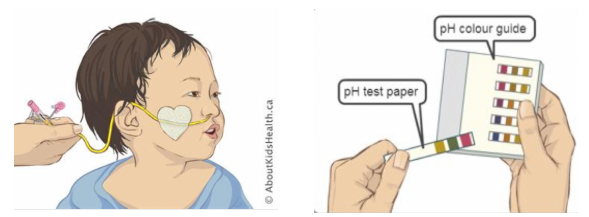ALERT: What is best practice for confirming placement of NG tubes?
Connected Care Quick Hits are up to date and evidence based recommendations for the care of children with medical complexity & technology dependence, from hospital to home.
ALERT: What is best practice for confirming placement of NG tubes?
SITUATION:
This QuickHit comes from questions from community/home care providers regarding the most up to date practice for checking the placement of NG tubes.
BACKGROUND:
A nasogastric (NG) tube is a long, thin, hollow tube that is passed through a nostril into the throat and down into the stomach.
NG tubes are used to provide hydration, medications, and enteral feeds to children who are unable to safely take food or liquids by mouth or to supplement oral intake.
While often used in home care and considered safe to do so in many instances, risks associated with use of NG tubes include displacement with the potential to cause discomfort with feeding and aspiration to the lungs.
ASSESSMENT:
Routine assessment of checking the placement of NG tubes before their use enables verification that the tube is still in the stomach and safe to use.
NG tube placement is to be assessed:
Before each use of the tube for feeds and/or medications
When a new tube is inserted
When there is concern that the tube may have been pulled out or changed position
There is choking, vomiting, coughing or breathing trouble
Every 8 hours during a continuous feed
RECOMMENDATION:
Connected Care recommends following the most up to date best practice for checking NG tube placement. This involves assessing the pH of stomach contents aspirated from the tube.
Auscultation and listening for a gastric "pop" is NOT a reliable method for checking NG tube placement and should NEVER be used to confirm tube placement
To Check NG Tube Placement
Attach an empty syringe to the NG tube and gently flush with air to clear the tube. Then pull back on the plunger to withdraw stomach contents.
Empty the stomach contents on to all three squares on the pH testing paper and compare the colors with the label on the container.
For most children, the colour on the strip should be less than 4 (pH<4).
For children on stomach acid suppressing medications or who have just been fed, the reading should be less than 6 (pH<6).
These readings indicate the NG tube placement is correct and the tube is safe to use. You may flush the tube and proceed to use.
Click here for step by step instructions for each method including a video on venting
Troubleshooting:
If a pH of more than 6 (pH>6) is obtained, wait 15-30 minutes and test the stomach contents again.
If unable to obtain stomach contents, then try the following
Insert 5 to 10 ml of air into the tube and attempt to slowly aspirate again
Change the child's position by placing them on their left side, wait a few minutes and try again.
Use a larger syringe and draw back more gently to prevent collapsing of the tube
If unable to obtain aspirate, or for a repeated pH reading of more than 6 (pH>6), DO NOT use the NG tube. Partner with the family caregiver to determine next steps which may include removing and re-inserting the tube or visiting the ED to confirm placement via x-ray.
Monitoring:
Children with NG tubes are to be monitored for the following during feeds
Abdominal discomfort, bloated stomach
Feeding intolerance, such as vomiting, diarrhea, or gagging
Any difficulty with cough or breathing
If any of these problems occur, stop the feed right away and do not use the tube. Notify the family immediately and seek appropriate medical attention, such as going to the emergency room or calling 9-1-1.
For more information on NG tubes in children visit AboutKidsHealth
If you are unsure about this practice, consider a ‘real time’ consult to Connected Care, and we can support the safety check.
Connected Care Live is not to be used in the event of an emergency.














